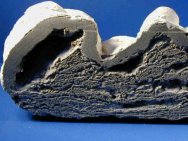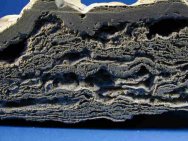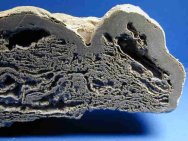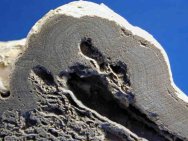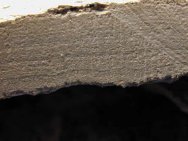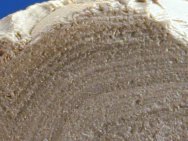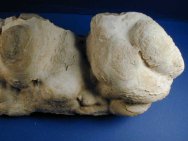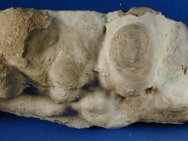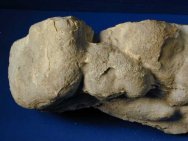|
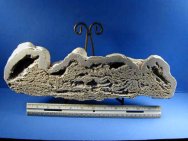 This
is for all practical purposes, modern stromatolite, coming from
the famous selenite collecting beds of Lake Marion, Australia.
In fact, the specimen contains crystals of selenite. The specimen
also exhibits extremely fine layering. The material is difficult
to obtain. Coming from a lake/lagoon environment with brackish
and hypersaline water, this stromatolite is an example of how
modern stromatolite has retreated to less hospital habitats where
competition from other forms is reduced. This
is for all practical purposes, modern stromatolite, coming from
the famous selenite collecting beds of Lake Marion, Australia.
In fact, the specimen contains crystals of selenite. The specimen
also exhibits extremely fine layering. The material is difficult
to obtain. Coming from a lake/lagoon environment with brackish
and hypersaline water, this stromatolite is an example of how
modern stromatolite has retreated to less hospital habitats where
competition from other forms is reduced.
The
specimen has been sliced horizontally below the upper domes. Thus,
both the exterior domes and the internal laminated structures
are available for study. This stromatolite has not been buried
for eons like most ancient 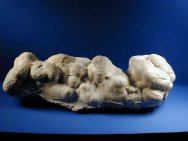 formations,
and has thus not undergone the morphological and chemical changes
like most of the specimens in this section. Thus, it strongly
resembles modern, living stromatolite. formations,
and has thus not undergone the morphological and chemical changes
like most of the specimens in this section. Thus, it strongly
resembles modern, living stromatolite.
We
will likely have no more than a sketchy understanding of the paleoenvironments
in which stromatolite was formed in the deep time Precambrian,
and only an incomplete understanding of the environments in the
Paleozoic. Sound conjecture is possible if we examine the now
rare environments that support extant stromatolitic growth during
modern times. Cyanobacteria are found to be a primary organism
in the formation of microbial carbonates. These prokaryotic bacteria
(slang name is blue-green algae owing to pigmentation involved
in photosynthesis) are now only found in areas where there is
reduced grazing and burrowing by other organisms, and a low occurrence
of macro-algae and plants. Environments where modern stromatolites
are found typically are hypersaline, but also include areas of
high alkalinity, low nutrients, high or low temperatures, and
strong wave or current actions. The obvious pattern emerges that
modern stromatolites tend to exist in areas that most other life
forms consider less desirable or possibly intolerable. Thus, organisms
producing modern stromatolite are generally limited to areas where
organisms with which they have to compete and/or organisms that
might use them for nutrients are not prevalent.
Also
see: Stromatolites
Across Geologic Time |


